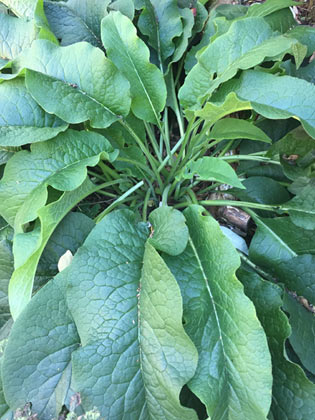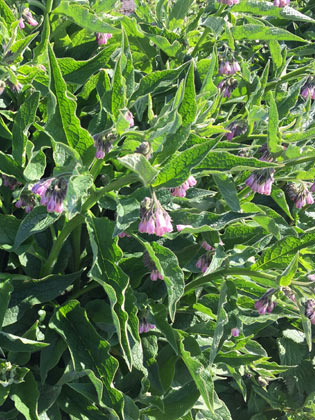
- Food forest
- Bees and butterflies
- Medicinal
Comfrey (Bocking 14)
Symphytum x uplandicum
Large non-invasive comfrey that has multiple uses in the garden as a nutrient accumulator, pollinator-friendly plant and weed barrier. Well known for its medicinal uses.
PLANT TYPE Herb
PLANT HABIT Deciduous perennial
USES Medicinal, Pollinators
DESCRIPTION
Not edible. For medicinal and gardening uses only.
In the garden Bocking 14 is an excellent plant for pollinators. In the UK, bumblebees treasure it’s spring/summer flowers and “nectar rob” by eating holes through the sides of the flowers, which honeybees then also take advantage of.
Has a higher potash content of most comfreys, making it the best for liquid manure, or for cutting back as a nutrient rich mulch and as a compost activator. As it’s a quite large plant, Bocking 14 hedges also make effective weed barriers and edges for gardens.
Has a deep taproot known to run up to 8 feet in to the earth. For this reason, Bocking 14 is a nutrient accumulator and can access soil profiles other plants on your site probably won’t. In this sense Bocking 14 effectively “mines” your site for minerals and then dumps them on the soil surface as nutrient rich leaves.
Unlike the common comfrey, Bocking 14 is a sterile hybrid doesn’t spread via seed.
Mauve flowers spring and early summer. Thrives in most soils or situation, does best under shade of trees and will do well in full sun.
PRODUCT NOTES Crown cuttings in winter 5 x £11.00 Root cuttings in Summer x 8 £8.50
RECOMMENDED LOCATION Forest garden, Wildlife garden
Aspect Full sun, Partial sun, Shade, Moist shade, Dry shade, Moist partial shade, Dry partial shade, Moist full sun, Dry full sun
Height 1.25m
Spread 1.25 - 1.75m. Flower spikes flop over in late Summer giving this plant an additional spread of up to ~1.75m
Hardiness Very hardy
Management and care When planting from root cuttings will reach maturity in 2-3 years. Unlike the common comfrey, Bocking 14 is a sterile hybrid doesn’t spread via seed. Whilst not being invasive via seed, after becoming well established (after 4-5 years) Bocking 14 will start spreading underground via quite large runners which come up a metre or so away from the original plant. They are not hard to control, however. Simply digging the runners back to the main plant keeps it in one area.
Origin/history
A variety developed from large Russian comfreys by Lawrence D Hills at the Henry Doubleday Research Association (HDRA).
FAMILY: Boriginaceae

